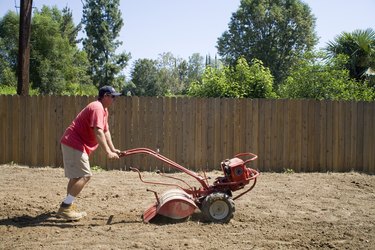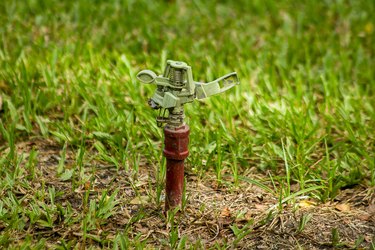Quck answer
To start a lawn from seed, follow these steps:
1. Prepare the soil: Remove any existing grass or weeds and loosen the top layer of soil.
2. Choose the right seed: Consider factors like climate, sunlight, and soil type to select the appropriate grass seed.
3. Spread the seed: Use a spreader or your hands to evenly distribute the seed over the prepared soil.
4. Water regularly: Keep the soil moist but not waterlogged by watering the seeded area regularly.
5. Fertilize: Apply a slow-release fertilizer to promote healthy growth.
6. Patience is key: It takes time for the grass to grow, so be patient and continue to care for the new lawn.
7. Mow and maintain: Once the grass reaches a suitable height, mow regularly and provide proper maintenance to keep it healthy.
By following these steps, you can successfully start a lawn from seed and enjoy a lush, green yard.
If you’ve ever wanted to grow a lush and vibrant lawn from seed, you’re in luck! It may require some effort and dedication, but the process is actually quite straightforward. Unlike other plants that take months to mature, grass seed can germinate and sprout within just a couple of weeks, and before you know it, you’ll have a beautiful green lawn to enjoy.

Grass seed germinates quickly and takes root in a matter of days.
Image Credit:
indigolotos/iStock/GettyImages
There are a few key factors to consider when starting a lawn from seed in order to ensure its success. First and foremost, you’ll need to properly prepare the soil, choose the right type of seed, and apply the seed in the correct quantity. And of course, regular watering is essential for the grass to grow. Once the lawn is fully established, you can adjust your watering schedule accordingly.
Selecting the Right Seed and Planting Time for Your Climate
Before you begin, it’s important to consult with your local extension service to determine the best time of year to seed your lawn based on your specific climate. They can also provide valuable advice on the most suitable types of grass seed to use, as well as other important aspects of lawn establishment, such as watering schedules and common mistakes to avoid.
The choice of seed and the local climate can greatly impact the success of your lawn. For example, if you live in the Denver area, the extension service at Colorado State University recommends seeding warm-season grasses between April and July, but advises against seeding after July. On the other hand, cool-season grasses can be seeded anytime between March and September. If you reside in an area above 7,000 feet, the advice is to use only cool-season grasses and seed your lawn in the spring. Keep in mind that these are general guidelines, and it’s always best to consult with experts in your region, such as a university extension service or a knowledgeable local garden center professional.
Preparing the Seed Bed for Your New Lawn
Almost all soil requires some preparation in order to create an ideal growing bed for grass seed. The extension service at Iowa State University emphasizes the importance of conducting a soil test to determine the necessary fertilization and amendments. Once you have the results, you can fertilize the soil accordingly and till it to a depth of 4 to 6 inches using a rototiller or other suitable equipment (for smaller areas, a shovel can be used to turn over the soil, similar to a garden bed).

Using a rented tiller can speed up the soil preparation process.
Image Credit:
Shawn Frederick/Stockbyte/GettyImages
A soil test can be done at your local extension office and will reveal any nutrient deficiencies in the soil, such as nitrogen or phosphorous. Based on the test results, choose a fertilizer blend and apply it as directed by the manufacturer. After fertilizing, proceed to till the soil. It is important to note that this is your only opportunity to provide the necessary nutrients to the root zone of your new lawn.
In addition to fertilization, if the soil is hard and compacted, it should be amended with sand and compost during the tilling process. The ideal seed bed depth is around 4 inches, consisting of equal parts black dirt (topsoil), sand, and compost. It is unnecessary to add several inches of topsoil or cover the seed with a thick layer of topsoil. According to the CSU extension, a light raking after seeding is sufficient, and they advise against covering the seed with topsoil or sand.
Once the soil is disturbed, use a rake to even out the surface and fill in any holes or depressions. This is also a good opportunity to remove any large rocks that cannot be embedded into the soil. Finally, lightly compact the soil by rolling it with a lawn roller. The Michigan State University extension suggests using a roller weighing between 200 and 300 pounds (which can be increased by adding water) and states that the soil is ready when it compresses about 1/2 inch under the pressure of a shoe heel.
Applying the Lawn Seed
Grass seed thrives when it is applied evenly and in the correct amount. Avoid the temptation to scatter extra seed, thinking that more seed will yield better results. Excessive seed may indeed result in a lot of grass, but the plants will be overcrowded and will have to compete for survival. It is better to have too little seed than too much. Grass is capable of filling in small bare spots on its own, but if there are large areas remaining after the rest of the grass has grown in, simply reseed those areas.
Apply the seed in two passes using a push-behind (drop) spreader. Follow the recommended seeding rate provided by the seed manufacturer and local extension office. To ensure even distribution, apply half of the seed to the entire area in an east-west direction, and then apply the remaining half in a north-south direction, perpendicular to the first pass.

Apply the seed in two perpendicular passes.
Image Credit:
Penn State College of Agricultural Science
Gently rake the seed bed to smooth the soil surface and lightly cover the seeds with soil. It is not necessary to cover all of the seeds as they can sprout from the surface, but they may not thrive if they are buried too deep. Some seed manufacturers recommend using a lawn roller to slightly embed the seeds into the surface. If directed or desired, you can also do this.
Watering Your New Lawn
Immediately after seeding, lightly water the seed bed. The entire surface should be wet, but there should not be any pooling water or runoff that can wash away the seeds. Afterward, water regularly, two to four times per day, to keep the soil moist without saturating it. Under ideal conditions, grass seed germinates within 7 to 14 days. However, in unusually hot or cloudy weather, it may take longer. If you water enough to keep the soil dark and avoid overwatering, the sprouts will emerge.

Hand-watering is recommended for newly seeded areas, but sprinklers are necessary for large lawns.
Image Credit:
Puripat penpun/iStock/GettyImages
Once the new grass reaches a height of 1 to 2 inches, you can reduce the frequency of watering depending on the weather and climate. However, in dry areas, neglecting to water properly can have disastrous consequences. Keep a close eye on the moisture levels until the grass is fully established.
Mowing and Maintaining a Seeded Lawn
You may be eager to mow your new lawn as a symbol of its establishment. On the other hand, you may be hesitant to cut those tender green blades with a mower. The best approach is to find a compromise as mowing at the right time actually promotes new growth. The ideal time to mow varies depending on the type of grass, so follow the recommendations provided by the seed manufacturer.
To illustrate, the ISU extension recommends mowing Kentucky bluegrass for the first time when it reaches a height of 3 to 3 1/2 inches. It is essential to only trim one-third of the blade length. For instance, if the grass is 3 inches long, you should only cut it by 1 inch, leaving at least 2 inches of grass. If the grass grows too long, it is advised by ISU to trim it in stages, removing only one-third of its length each time and waiting several days between stages. Trimming more than a third of the grass’s length, regardless of its original length, can result in scalping, which means cutting the grass too short and damaging it.

It is crucial not to delay mowing and avoid cutting the grass too short.
Image Credit:
Sandra Dombrovsky / EyeEm/EyeEm/GettyImages
To ensure the strength of your new lawn, continue watering and mowing it diligently. Avoid using harsh fertilizers, particularly weed killers, until the lawn is fully established. If new weeds emerge with the grass, you can apply most broadleaf weed killers after mowing the lawn three or four times.

